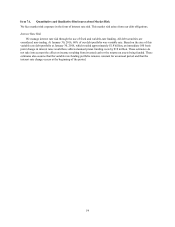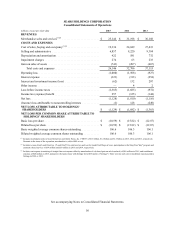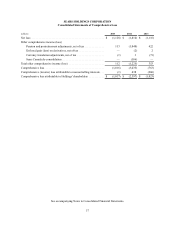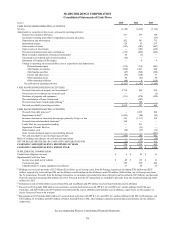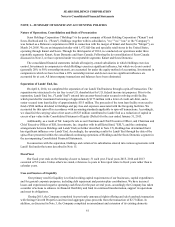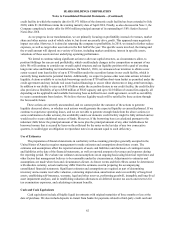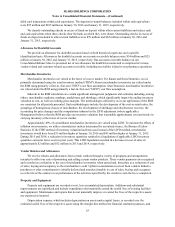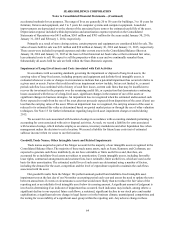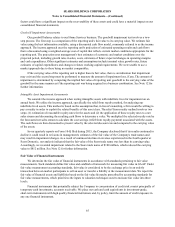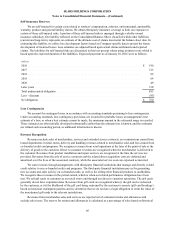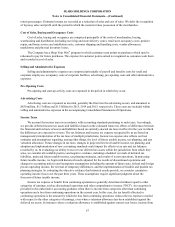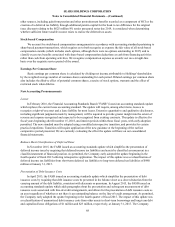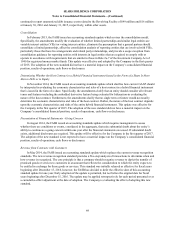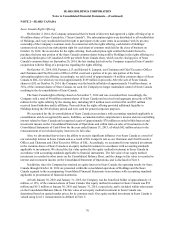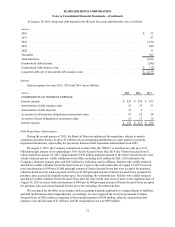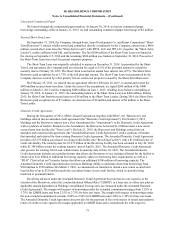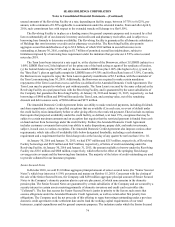Sears 2015 Annual Report Download - page 64
Download and view the complete annual report
Please find page 64 of the 2015 Sears annual report below. You can navigate through the pages in the report by either clicking on the pages listed below, or by using the keyword search tool below to find specific information within the annual report.
accelerated methods for tax purposes. The range of lives are generally 20 to 50€years for buildings, 3 to 10€years for
furniture, fixtures and equipment, and 3 to 5€years for computer systems and computer equipment. Leasehold
improvements are depreciated over the shorter of the associated lease term or the estimated useful life of the asset.
Depreciation expense included within depreciation and amortization expense reported on the Consolidated
Statements of Operations was $415 million, $563 million and $703 million for the years ended January€30, 2016,
January€31, 2015 and February€1, 2014, respectively.
Primarily as a result of store closing actions, certain property and equipment are considered held for sale. The
value of assets held for sale was $31 million and $30 million at January€30, 2016 and January€31, 2015, respectively.
These assets were included in prepaid expenses and other current assets in the Consolidated Balance Sheets at
January€30, 2016 and January€31, 2015 at the lower of their historical net book value or their estimated fair value,
less estimated costs to sell. We expect to sell the properties within a year and we continually remarket them.
Substantially all assets held for sale are held within the Sears Domestic segment.
Impairment of Long-Lived Assets and Costs Associated with Exit Activities
In accordance with accounting standards governing the impairment or disposal of long-lived assets, the
carrying value of long-lived assets, including property and equipment and definite-lived intangible assets, is
evaluated whenever events or changes in circumstances indicate that a potential impairment has occurred relative to
a given asset or assets. Factors that could result in an impairment review include, but are not limited to, a current
period cash flow loss combined with a history of cash flow losses, current cash flows that may be insufficient to
recover the investment in the property over the remaining useful life, or a projection that demonstrates continuing
losses associated with the use of a long-lived asset, significant changes in the manner of use of the assets or
significant changes in business strategies. An impairment loss is recognized when the estimated undiscounted cash
flows expected to result from the use of the asset plus net proceeds expected from disposition of the asset (if any) are
less than the carrying value of the asset. When an impairment loss is recognized, the carrying amount of the asset is
reduced to its estimated fair value as determined based on quoted market prices or through the use of other valuation
techniques. See Note 13 for further information regarding long-lived asset impairment charges recorded during
2015.
We account for costs associated with location closings in accordance with accounting standards pertaining to
accounting for costs associated with exit or disposal activities. As such, we record a liability for costs associated
with location closings, which includes employee severance, inventory markdowns and other liquidation fees when
management makes the decision to exit a location. We record a liability for future lease costs (net of estimated
sublease income) when we cease to use the location.
Goodwill, Trade Names, Other Intangible Assets and Related Impairments
Trade names acquired as part of the Merger account for the majority of our intangible assets recognized in the
Consolidated Balance Sheet. The majority of these trade name assets, such as Sears, Kenmore and Craftsman, are
expected to generate cash flows indefinitely, do not have estimable or finite useful lives and, therefore, are
accounted for as indefinite-lived assets not subject to amortization. Certain intangible assets, including favorable
lease rights, contractual arrangements and customer lists, have estimable, finite useful lives, which are used as the
basis for their amortization. The estimated useful lives of such assets are determined using a number of factors,
including the demand for the asset, competition and the level of expenditure required to maintain the cash flows
associated with the asset.
Our goodwill results from the Merger. We perform annual goodwill and indefinite-lived intangible asset
impairment tests at the last day of our November accounting period each year and assess the need to update the tests
between annual tests if events or circumstances occur that would more likely than not reduce the fair value of the
reporting unit or an indefinite-lived intangible asset below its carrying amount. A significant amount of judgment is
involved in determining if an indicator of impairment has occurred. Such indicators may include, among others: a
significant decline in our expected future cash flows; a sustained, significant decline in our stock price and market
capitalization; a significant adverse change in legal factors or in the business climate; unanticipated competition; and
the testing for recoverability of a significant asset group within the reporting unit. Any adverse change in these
SEARS HOLDINGS CORPORATION
Notes to Consolidated Financial Statements—(Continued)
64


